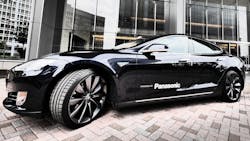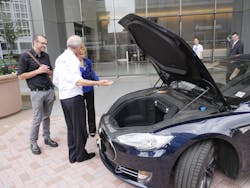When I accepted the invitation to tour Panasonic's new North American headquarters in Newark, N.J., last month, I expected long tours of 4K screens and enormous LED displays. I thought I'd see some slick new appliances, maybe a stack of batteries on display somewhere.
I was not expecting to find a Tesla Model S parked out front ready for a test drive.
I shouldn't have been surprised, though.
Panasonic has been working with Tesla since 2007, back when Elon Musk's start-up electric car company was more pipe-dream long shot than anything else.
"Tesla wasn't even on the radar then," explains Jeff Howell, president of Panasonic's U.S. Industrial Devices sales division.
"The Prius was getting popular then, and the whole idea of electrification of vehicles and alternative power was something we were very engaged in. So we made what proved to be a smart decision to invest in Tesla back then."
Smart indeed.
Today, Panasonic supplies the battery cells that power the Model S, a deal that has put the company on the front line of Tesla's rise. Panasonic is a key partner in Tesla's Gigafactory, and has even launched a new manufacturing company devoted to lithium-ion batteries -- Panasonic Energy Corporation of North America -- which will work within Tesla's battery module operation.
So Tesla, and particularly this model, has become a key focus for Panasonic. It positions the company away from the consumer products of its past and into the cutting edge of component technologies.
"We're now 80% non-consumer," Howell explains. "We're doing business with all of the major corporations, all of the major tech titans, all of the major tech conglomerates all over the world."
"We're the component guys now," he says. "Our Model S is our way of demonstrating that."
It's a convincing demonstration.
A Close-Up Look at the Model S
To date, most hybrid and alternative power vehicles have something almost cute about them in their designs. They tend to sell to environmentally conscious buyers -- drivers willing to pay a premium to help save the world in some way. The cars generally reflect the aesthetics of that market.
But the Model S is all business.
Its body is slick and streamlined. It contains no hard angles, no breaks, no superfluous add-ons or details to interrupt its aerodynamic flow. Even the door handles retract into the frame to cut down on drag.
Add to that the newspaper-sized tablet in the dash and the glow of the liquid crystal displays, and the difference between this and other alternative energy cars becomes even clearer.
There is nothing cute about the Model S. It's not designed to impress the save-the-world, conscience-buyer market; it's designed to compete in the BMW and Mercedes market on their own turf. If it helps save the world in the process, all the better.
Inside the Model S, the all-electric aspect of it seems almost immaterial to the design. It's just another premium feature in what seems like an endless supply of premium features.
Until you hit the accelerator.
According to Dan Unger, the PR manager at Panasonic North America and the pilot for my test drive, Panasonic bought the Model S back in 2012 to serve as a showpiece for visitors, investors and even local employees.
The thinking went, he says, rather than subjecting guests to a PowerPoint presentation detailing the capabilities of its battery technology, why not let them experience it firsthand?
And that's how I found myself in the passenger seat, cruising through downtown Newark. At first, minus the absence of engine noise, the electric part of the car seemed practically nonexistent. The car is quick to accelerate and feels like a high-performance car cruising around the city. There was no softness to it, nothing overtly "alternative" about its power.
It is a $75,000 car that seems to drive like $75,000 car. It turned a lot of heads, but so would anything else in its price class.
But that was city driving. The freeway was something else.
Unger pulled on the ramp leading to Route 21 at a slow 30 mph to give us room to accelerate. Once he found a hole in the traffic, he looked over and asked, "Are you ready?"
"Sure," I said. But I wasn't.
He floored the accelerator and the car lurched forward in a way I have never experienced in anything but a rollercoaster, maybe. There was no lag in the motor, none of the usual engine fire, no revving up or building momentum. The moment he hit the pedal, it was 100% acceleration.
In under a second, we lurched from a crawling 30 mph to merge into traffic at over 60. But Unger wasn't done.
At 60 mph, he floored it again and the whole scenario replayed itself -- the same lurch, the same G-force, the same power and acceleration it had from 30 mph.
If he had done it again at 90, Unger said, it would feel the same.
We cooled back off from that blast of acceleration to a more appropriate speed and the blood eventually returned to my face, but not my clenched fists.
Unger seemed content with that result.
"And that," he said, "is what Panasonic technology can do."
"Sure beats a PowerPoint," I said.
About the Author
Travis M. Hessman
Editor-in-Chief
Travis Hessman is the editor-in-chief and senior content director for IndustryWeek and New Equipment Digest. He began his career as an intern at IndustryWeek in 2001 and later served as IW's technology and innovation editor. Today, he combines his experience as an educator, a writer, and a journalist to help address some of the most significant challenges in the manufacturing industry, with a particular focus on leadership, training, and the technologies of smart manufacturing.

